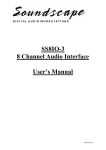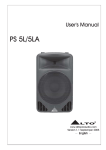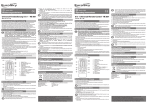Download Mark Levinson JC-2 Instruction manual
Transcript
INSTRUCTION MANUAL for the JC-2 PREAMPLIFIER IMPORTANT Please read these instructions carefully and completely before operating the JC-2 preamplifier. A great deal of effort went into the design and construction of this precision device. Understanding its functions will enable you to use it to fullest advantage. INSTRUCTION MANUAL for the JC-2 PREAMPLIFIER 1. INTRODUCTION The MARK LEVINSON JC-2 PREAMPLIFIER is the distillation of years of scientific research and careful listening. The amplification circuitry designed by John Curl combines the advantages of class A, completely complementary push-pull operation, high open-loop bandwidth, and low feedback configurations in order to approach perfect solid-state preamplification of the most demanding recorded musical material. Handmatched active and passive components not previously used in consumer audio equipment eliminate subtle forms of error and distortion which plague sensitive ears. Mark Levinson Audio Systems utilizes the finest test equipment in its product development program. More significantly, a large number of our staff participate in the evaluation of these developments and refinements. When a product is made available, it is only after it has proved itself on a wide variety of sophisticated sound systems. To realize the full potential of these developments is a laborious and difficult task. But - here is a true designer’s choice for the classic system. 2. UNPACKING THE JC-2 Inspect the unit for damage. It should be physically free of dents and scratches. If the unit has incurred any damage, contact your dealer immediately. Retain all packing material for future shipping. Shipments made in anything other than the original carton will invalidate the warranty, unless authorized by factory. 3. 3.1. INSTALLATION Connectors The JC-2 is equipped with phono connectors for all audio inputs and outputs. There are two cannon receptacles for connection to the power supply. A binding post is provided for ground connections to the chassis of the JC-2. 3.2. Power Supply Connection The power supply for the JC-2 is mounted in a separate chassis to eliminate hum pick-up. Check the voltage the power supply comes a cable with a three power supply label to be sure they correspond to the voltage of the power source being used. From one end of the power supply comes a cable with a three prong AC plug on the end of it. Connect this end to a wall outlet, using a ground adapter plug if your wall outlet will not accept three prongs. From the other end of power supply comes a cable with a cannon connector on the end of it. Connect this end to the four-pin male cannon connector on the rear of the JC-2. This should be done before connecting the JC-2 to the power amplifier because there is a transient thump when power is first applied to the unit. POWER SUPPLY CONNECTOR PIN CONFIGURATION: 3.3. Pin 1 - ground Pin 2 - + V Pin 3 - - V Pin 4 - no connection Rack Mounting The JC-2 may be mounted in a standard 19" relay rack. (The rubber feet may be unscrewed if necessary.) 10-32 screw should fit the threads on most racks. Be sure to use nylon washers when mounting the JC-2 so as not to scratch the unit. 4. 4.1. OPERATION Description of Controls INPUT SELECTOR - selects any one of six inputs. AUX., TUNER, TAPE 1, TAPE 2, and REMOTE PHONO are all high level inputs. PHONO 1 is an RIAAequalized low level input. The REMOTE PHONO input is an unequalized high level input. It is intended for use with phono systems having their own amplification and equalization, such as the EMT turntable/ cartridge system, or certain of strain gauge cartridge. INPUT/MONITOR - switches between the program source at the input selector or either of two tape monitor inputs. This switch will not affect the tape outputs. When making copies from one machine to another through the JC-2, the playback machine should be directed through the input selector rather than the input/monitor switch. Tape copies can be made in this manner without degradation of signal because there are no amplifiers between the input selector and the tape outputs. TAPE 1/TAPE 2 - selects either tape input 1 or tape input 2 for the input/ monitor switch. MONO/STEREO - selects either a mono or a stereo mode at the main outputs. HIGH/LOW - selects either 21dB gain (HIGH) or 11dB gain (LOW) in the output stage. Line level inputs should generally be used only with the low gain setting. Low level phono inputs can be used with either HIGH or LOW depending on the output level of the phono cartridge. If when using the low gain position, the output level control is set close to maximum for a pleasing level, i. e. above 7 or 8, turn down the output level and switch to the high gain position. This will give a broader range of operation for the output level control. Conversely, if in the high gain position the output level control is set below 1 or 2, switch to the low position. This switch does not affect the tape outputs. BALANCE 1 and 2 - these switches are used to precisely set channel balance for a correct stereo panorama. There is a total range of nine dB in one dB steps for each channel. The normal position for these controls is 0dB. At this position there is a gain in the output stage of 11dB in the LOW gain setting, and of 21dB in the HIGH gain setting. These controls do not affect the tape outputs. OUTPUT LEVEL - adjust volume at the main outputs for both channels simultaneously. 5. 5.1. OPTIONS The JC-2 Modular Plug in Phono System (from S/N 1122) The basic JC-2 Preamplifier contains two extremely high performance ultra-low noise amplifiers encapsulated in special thermal epoxy. The external regulated power supply and the internal active filter in the JC-2 make it possible to incorporate very high gain phono circuitry with great immunity to hum pick-up and other power supply noise. A series of plug-in cards is available, containing equalization and other circuitry to match the characteristics of the phono section to practically every cartridge available now and in the future. The basic amplifiers and the plug-in cards feature gold-plater pins and sockets for highest reliability. As part of this system, MLAS offers a revolutionary moving coil cartridge amplifier which provides DIRECT input, WITHOUT BOOSTER AMPLIFIER, of even the lowest output MC cartridges. The input stage accepts 7 millivolts at 1kHz, and 70 millivolts at 20kHz, which allows enough headroom for the highest peaks it is possible to encounter (80cm/s). Transient distortion has been greatly reduced, giving a significant increase in transparency and openness of sound. This system includes one JC-1SM plug-in card and two Universal Phono plug-in cards (see below). UNIVERSAL PHONO PLUG-IN CARDS System: Gain: Overload: 1kHz 20kHz A Two UP-1A cards are normally supplied with the JC-2 unless otherwise specified. This system accepts Input impedance: 47kOhms. 36dB 100mv 900mv B The UP-1B system offers lower sensitivity but increased headroom for the highest output magnetic phono cartridges. 30dB 220mv 1.6v C This set provides exact equalization for the Brüel & Kjaer series of cartridge measurement records. Information on request. D This system includes two UP-1D cards and a JC-1SM module. It offers DIRECT moving coil cartridge input. 70dB 7mv 70mv E Provides equalization and DC current source for certain gauge cartridges. Information on request. F Flat response amplification. Specify application and requirements. The JC-2 may be ordered with any set of these plug-in cards. Alternate sets may be purchased at any time. Custom UP-1 cards can be supplied; contact the factory regarding your special application. Frequent changing of the cards is not recommended, but may be done. If you have any questions concerning the characteristics of a certain cartridge, please contact your dealer or the factory with regard to appropriate plug-in cards. 5.2. Wood and Lexan Case A special case of original design is available for the JC-2 Preamplifier. The engraving on the top plate of the JC-2 is visible through a lexan window inset into the of the case. 6. SPECIFICATIONS Phono Section: Gain* OVERLOAD POINT* 1kHz 1kHz 36dB 100mv min. MAXIMUM OUTPUT CHANNEL TRACKING FREQUENCY RESPONSE 18Hz to 20kHZ 18Hz to 20kHz -1.5dB down at 6v min. .5dB ( .2 typ.) 18Hz, 30kHz min. NOISE below 10mv, inputs shorted below 10mv, 600ohms load 18Hz to 20kHz: 85dB 83dB ASA "A" weighted 90dB min. 88dB *(see also Section 5) INPUT IMPEDANCE RECOMMENDED LOAD OPEN LOOP BANDWIDTH SLEW RATE NOISE (JC-1SM) 47kOhms* 10kOhms or higher 1500Hz min. 20V/microsecond below 1mv input better than 85dB Line Section: FREQUENCY RESPONSE MAXIMUM OUTPUT GAIN NOISE INPUT IMPEDANCE RECOMMENDED LOAD OPEN LOOP BANDWIDTH SLEW RATE POWER SUPPLY CURRENT SIZE WEIGHT Flat ±.2dB, 20Hz-50kHz, -1dB at 12Hz, 100kHz 10V HIGH 21dB LOW 11dB below 2.5V 100dB min. HIGH 10kOhms min. LOW 30kOhms 10kOhms or higher 40kHz 100V/microsecond (min.) external ±15V at 300ma regulated and filtered. Internal additinal active filter for phono section. approx. ±250ma at ±15V 19" X 2"X 6 1/8" approx. 6lbs. with power supply 7. WARRANTY All MARK LEVINSON products are guaranteed for five full years from date of purchase. Parts and labor will be furnished free of charge. The manufacture assumes no responsibility for damaged or abused equipment and reserves the right to determine cause of defects. IMPORTANT: Addendum to Section 4 An output coupling selector switch is located between the line amplifiers on the main circuit board. When switched to the right (factory set position) the line outputs are AC coupled for driving direct coupled power amplifiers. When switched to the left, the line outputs are direct coupled for friving AC coupled amplifiers. NEW DEVELOPMENTS IN THE JC-2 JC-2 Preamplifiers starting with serial number 2148 differ from previous units. They are equipped with lemo connectors, a new power supply (PLS-150), two phono inputs and new phono plug-in cards. PHONO SECTION The standard systems are now A3, D5 and d6. The plug-in cards contain a two-station program switch for selection of input and gain characteristics. System Rocker Switch Function Open Closed A3 1 2 input impedance gain 100k 30dB 50k 40dB D5 1 2 CRC* gain CRC out 54dB CRC in 60dB D6 1 2 CRC gain CRC out 60dB CRC in 66dB System A3 permits optimum loading for cartridges such as the B & O, Grace and Audio Technica types which are designed for 100kOhms termination. Certain high output moving coil cartridges such as the EMT, the Supex 901, the Satin and the Ultimo, may be used in more efficient systems with the 40dB gain implemented. System D5 and D6 are identical except for the gain. Both offer switchable CRC for flattening the high frequency response of certain cartridges like the Fidelity Research FR-1Mk3, the Ortofon SL15 (original type), and certain other moving coil types (high frequency response varies from batch to batch of most MC cartridges.) System D5 offers 54 and 60dB gain positions. 60dB gain is the same as previously supplied by our System D and D1. 66dB is especially intended for use with low output MC cartridges such as the FR-1 Mk2 and Mk3 when used with inefficient systems requiring more voltage gain in the preamp. WHEN NOT OTHERWISE SPECIFIED, SYSTEM D6 WILL BE DELIVERED. Selecting the appropriate gain for the record output level may be accomplished by selecting the right phono plug-in systems. Note: System A3 cards MAY BE USED in earlier units. System D5 and D6 MAY NOT BE USED in earlier units. To accomplish the switching facility, differences had to be incorporated in the modules which DO NOT ALLOW Compatibility. For detailed information, contact the factory. For any questions concerning individual units, give us the SERIAL NUMBER of JC-2 in question. *CRC: Cartridge Resonance Compensation. The CRC circuit supplied rolls the high frequency response at 6dB per octave, -6dB at 20kHz. In particular, this curve has been successful in improving the performance of the FR-1Mk3. Other corrective curves are available on request. TONEARM CABLE ADAPTOR From an effort to simplify the connection of existing turntables to MLAS Preamplifiers fitted with Lemo connectors, we have developed the CA-1 cable adaptor. The CA-1 is a solid block of aluminum 2X2X .75" machined to exact tolerances and finished in our standard brushed black anodized surface. It replaces the phono connectors of any existing tonearm cable and allows connections to our preamps with an LL (Lemo to Lemo) cable set. (see page 11 of our 12-1-76 notice. ) The CA-1 contains two female Lemo connectors. You will need LL.6" or LL-3' cables to complete the connection from the turntable to the preamp. The CA-1 can be easily installed by anyone who can solder. Tools necessary are a write cutter and stripper, a soldering iron and solder, a small screwdriver and an allen wrench (included) for tightening the strain reliefs. A provision is made for mounting the CA-1 to a turantable base or shelf, with one wood screw. For tonearm cables having leads less than .1" diameter, the CA-1 is not necessary. Non-crimp style lemo connectors can be installed easily. Other applications for the CA-1 include adapting microphone and other kinds of cables to Lemo termination. Tonearm cables from Japan generally use thick leads due to their interest in low capacitance cable. This type cable is not very durable and has some disadvantages in spite of the claims of its proponents. Those cables terminating in goldplated phono connectors pose a hazard since gold really mates only with gold; gold to cadmium-plated phono connectors (the normal type) is worse than the standard phono connector to standard phono jack. The CA-1 is designed to accept all diameters of tonearm cable from the size just too big for non-crimp Lemos up to the heaviest Japanese type. INSTRUCTIONS FOR ASSEMBLING THE CA-1 CABLE ADAPTOR 1. The CA-1 may be mounted to a shelf, cabinet, or turntable base with one wood screw. This keeps fragile tonearm leads from breaking or flexing. 2. Use LL-.6 or LL-3 cables to connect with your JC-2 or LNP-2 preamplifier. 3. Cut the phono connectors from the tonearm leads, nothing which wire is left and which is right. 4. Strip the ends about 1/2" so that a center conductor and shield are prepared for each end. 5. Insert the wires through the small holes on the edge of the CA-1 so they project through the other side. 6. Solder the leads to the Lemo connectors, left and right. If the center Conductor wire is 26 gauge or smaller, it will fit in the connector pin; otherwise, wrap it around the pin and solder it. 7. Pulling the leads back through the CA-1 gently, install the front plate with the button head screws and the 1/16" wrench. 8. Drop the teflon pillows into the strain relief holes. 9. Insert the strain relief screws and tighten gently. The system you just assembled is the closest thing to having one continuous wire from tonearm to the first state of preamplifier electronics. PLS-150 POWER SUPPLY SYSTEM JC-2 preamplifiers with Lemo connectors are equipped with the PLS-150 Power Supply. The PLS-150 Power Supply is considerably larger and heavier than the ones delivered with previous units. We recommend that it be positioned with the cable end facing the wall and the front plate facing forwards. In this way, the two LED' s will be visible. these lights indicate that the power supply is receiving the correct AC voltage and is delivering the correct DC voltage. If the AC light blinks or goes off, this indicates that the AC line voltage has dropped to unacceptable levels. If the DC light goes out it indicates that the power supply is no longer functioning. Should either of these lights go out, contact your dealer or factory for service. The PLS-150 Power Supply is a remote sensing design. This means that the power supply adjusts the voltage to be accurate at the preamp itself, adjusting for any effects of the cable and reducing cross modulation of the audio circuits to virtually zero. The PLS-150 chassis is removed from its cover by removing the four feet and single captive screw on top of the unit. Look inside if you want to, but don' t play with it unless you have specific instructions from the factory.





















